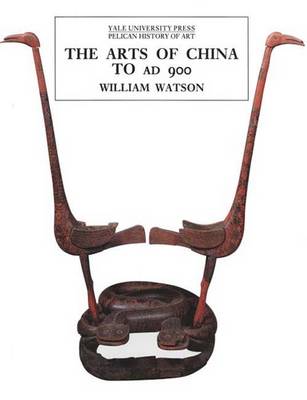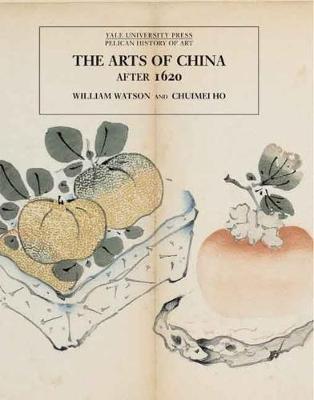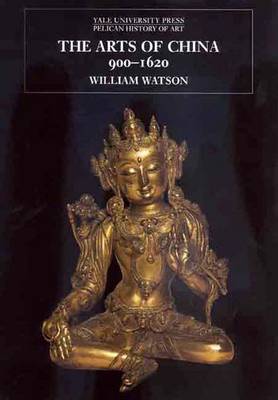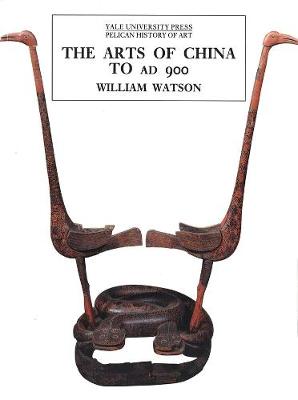The Yale University Press Pelican History of Art
4 total works
This work is the first in a three volume series that surveys China's wealth of art, architecture and artefacts from prehistoric times to the 20th century. It investigates the beginnings of the traditions on which much of the art rests, moving from Neolithic and Bronze Age China to the era of the Tang Dynasty around AD 900. The book discusses in detail a wide range of art forms and techniques: porcelain and pottery, lacquer art, religious and secular painting and sculpture, mural painting, monumental sculpture and architecture. It explains the materials and techniques of bronze casting, jade carving, pottery manufacture, and other arts and describes the most important sites, the artefacts that were produced at each one, and the historical interactions between different areas. There is a discussion of the iconography, the technique and the function of every art form. This book should be a valuable resource for both experts and beginners in the field.
In this volume, William Watson and Chuimei Ho begin with discussions of “fine” art and painting and progress to an analysis of carving and sculpture, ceramics, glassware, and textiles. The authors demonstrate how, in the age of the Emperors Kangxi, Yongzheng and Qianlong, the “decorative” arts rose to prominence in a way quite unlike the western experience. Avoiding misrepresentative categorization, they single out period styles, identify repeated phases of archaism and Buddhist art, and discuss characteristic groups of jade, ivory, ceramics, glassware, and textiles. They consider the importance of the imperial workshops and their role in developing craftsmen’s skills and encouraging the cross-over of techniques from different disciplines, and they direct attention to the compelling influence of Emperor Qianlong’s aesthetic innovations.
In architecture, the vast plan and overwhelming authority of the imperial buildings is discussed in contrast with the restrained subtlety of domestic architecture and garden design, where magnificent rocks were the principal feature just as in landscape painting. The survey concludes by examining the development of East/West trade and the effects of commercialization on Chinese arts and crafts. This is a handsome, well-illustrated book that will be a valuable and illuminating resource for all who are interested in the arts of China.
In architecture, the vast plan and overwhelming authority of the imperial buildings is discussed in contrast with the restrained subtlety of domestic architecture and garden design, where magnificent rocks were the principal feature just as in landscape painting. The survey concludes by examining the development of East/West trade and the effects of commercialization on Chinese arts and crafts. This is a handsome, well-illustrated book that will be a valuable and illuminating resource for all who are interested in the arts of China.
This beautiful book is the second in a major three-volume series that will survey China's immense wealth of art, architecture, and artefacts from prehistoric times to the twentieth century. It covers the most prolific and broad-ranging period of Chinese art history, from the Song Dynasty with its spectacular landscape paintings to the Ming Dynasty with its lovely pottery. William Watson considers architecture, painting, sculpture, and the decorative arts in equal balance. He follows styles and motifs as they are developed in each medium from one province to another and discusses materials and techniques as well as the iconography and function of every art form. He also explores relationships between one medium and another, tracing, for example, the influence of Buddhist iconography on sculptural traditions and on the architecture of temples and towers and showing how ceramic ornament affected the development of ornament in other media.
This book is the first in a major three-volume series that will survey China's immense wealth of art, architecture, and artifacts from prehistoric times to the twentieth century. The Arts of China to A.D. 900 investigates the beginnings of the traditions on which much of the art rests, moving from Neolithic and Bronze Age China to the era of the Tang Dynasty around A.D. 900.
William Watson discusses in lively detail a wide range of art forms and techniques: porcelain and pottery, lacquer, religious and secular painting and sculpture, mural painting, monumental sculpture and architecture. He explains the materials and techniques of bronze casting, jade carving, pottery manufacture, and other arts, and he describes the most important sites, the artifacts that were produced at each one, and the historical interactions between different areas. He discusses the iconography, the technique and the function of every art form. Written by one of the most distinguished scholars in the field of Chinese art and archaeology, this lavishly illustrated book will be a valuable resource for both experts and beginners in the field.
William Watson discusses in lively detail a wide range of art forms and techniques: porcelain and pottery, lacquer, religious and secular painting and sculpture, mural painting, monumental sculpture and architecture. He explains the materials and techniques of bronze casting, jade carving, pottery manufacture, and other arts, and he describes the most important sites, the artifacts that were produced at each one, and the historical interactions between different areas. He discusses the iconography, the technique and the function of every art form. Written by one of the most distinguished scholars in the field of Chinese art and archaeology, this lavishly illustrated book will be a valuable resource for both experts and beginners in the field.



